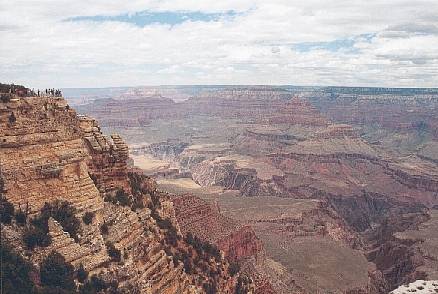
WOW, those were the first words out of my mouth when I first saw the Grand Canyon and it wasn’t what I expected. All along I had expected it to be beautiful, but it was more than that, it was awesome. It was also larger than I had envisioned. I had flown over it at 35,0000 feet and it didn’t look that big. lol Boy, was I surprised. It was a very fun day running around the park. We got there early and stopped at a few of the roadside shops. The locals were selling rings, and necklaces and other merchandise. We didn’t buy anything there, but did get a few things at the store at the visitor’s center. We spent most of the day there. We even had a picnic lunch at one of the picnic sites. It was a lovely place to stop and have lunch. 3
There were a few places to stop and look at the canyon and each one had a little different view and perspective. Some of the stops are Lipan Point, Moran Point, and Grandview Point. There is nothing I could say here that would do it justice. It is something everyone should see someday. Here is a link to the Grand Canyon website, or thecanyon.com also has somgood information.
Here is some history about the Grand Canyon according to the National Park Service.
Professional archaeologists believe that for a period of time, reaching back 3,000 to 4,000 years, the Desert Archaic people lived within the Grand Canyon. The strongest evidence of their having passed here are small willow-twig effigies called "split-twig figurines". Fashioned from a single twig, the Desert Archaics made representations of animals.
Pictographs were applied to rock with a crude sort of paint made of minerals mixed with plant juice or animal oils. Many images are still plainly visible, but time, weathering, and erosion will eventually obliterate them. Pictographs from many cultures are widely found in this region. The Desert Archaic seemed to vanish from the scene about 1,000 BC, possibly slowly blending their culture in with the next group of Indians to occupy the Grand Canyons, the Anasazi.
The Anasazi, who had been occupying lands east of the Grand Canyon for 600 years or so began drifting into the Grand Canyon region by 500 AD. By 800 AD, the Anasazi were entering a phase known as the Pueblo. Ruins of adobe houses in the Grand Canyon shows that Pueblo Indians lived in this area, probably as early as the 1200's. Spaniards from Francisco Vasquez de Coronado's expedition in 1540 were the first white men to discover the canyon. Fathers Escalante and Dominguez mapped the region and wrote of it. Others, mostly trappers and Indians ventured across it in the early 1800's. Settlement along the Utah border didn't occur until the mid-1800's. A group of Mormon missionaries led by Jacob Hamblin, hoped to find arable land for settlement. By 1860, and a third mission to the Hopi lands, Hamblin and his trailblazers knew the lay of the land. Hamblin discovered crossings of the Colorado River at the lowest end of the canyon, now know as Bonelli Landing and Pearce Ferry. In 1864, Hamblin and his men, using a raft made the first successful crossing of the Colorado River upstream at the confluence of the Paria River. Hamblin had now located crossings for the upper and lower ends of the Grand Canyon. Despite this the canyon was still virtually unexplored.
On 24 May 1869, Major John Wesley Powell (1834 - 1902), a Civil War veteran, and ten other men, set forth to explore the Colorado River and the Grand Canyon. Powell came back in 1870 to explore the North Rim Plateau and made a second expedition through Grand Canyon in 1872.
By the 1880's, a number of live stock companies were developing in the Grand Canyon area of Arizona. By the 1890's it was estimated that there were over 100,000 head of cattle and more than 250,000 head of sheep grazing the land.
Kaibab National Forest was established in 1883, taking most of the Kaibab Plateau and by the time the Grand Canyon National Preserve was established in 1906, most of the ranchers were out of business. Why? The land was now desolate with sagebrush where lush grassland had been. It had been grazed out.
James T. Owens was appointed warden of the Grand Canyon National Preserve. He built a cabin and set up a mountain lion hunting business. Some 12 years and 600 mountain lions later, Uncle Jimmy, as he was know, began buffalo ranching on the plateau. Preferring the lower reaches of House Rock Valley, the buffalo moved down from the Plateau. In 1926, the buffalo were sold to the State of Arizona.
The first tourist facility was constructed in 1917 on the North Rim by W.W. Wylie. It provided minimum accommodations and was located near Bright Angle Point. At the same time, tourists camps were being developed at Bryce Canyon and Zion. Stephen T. Mather, the National Park Service's first director, encouraged the development to encourage people to visit these areas. In 1919, Congress made the Grand Canyon Preserve a National Park and established it's use for the enjoyment of future generations as a recreational resource, as well as recognizing the region's scientific value.
Back to Our Home Page
Page last updated August 2014